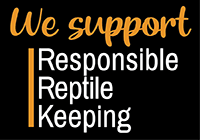10 common myths about reptiles and their care

10 Common Myths About Keeping Reptiles
Written by Mariah Healey, ReptiFiles.com
MYTH: Reptiles are inexpensive, easy pets.
FACT: More often than not, reptiles are expensive and require specialized care. They are NOT good pets for children. Unlike dogs and cats, which can wander around in your home, reptiles require their owners to essentially replicate nature in a box. At minimum, this requires knowledge of the reptile’s preferred range of temperatures and humidity, maximum UV Index tolerance, nutrition requirements, and how to use available materials and technology to keep the animal comfortable and healthy. This requires being able to retrieve and applying information from quality sources. Keeping a pet reptile also requires access to an experienced reptile veterinarian, which can be expensive and hard to find.
MYTH: Reptiles need friends.
FACT: Most reptiles prefer to live solitary. Unlike humans, reptiles are not naturally social creatures. They don’t really experience “loneliness.” Yes, some species are truly social and can be found living in groups in the wild, but this is the exception, not the rule. Housing antisocial reptiles together in the same enclosure often results in stress, injuries, and sometimes, death.
MYTH: Large enclosures cause stress.
FACT: Large enclosures only cause stress when they’re poorly laid-out. Take a look at nature, for example. Are these reptiles living in tiny boxes? Of course not! Even reptiles that are considered “sedentary” still travel significant distances every day in their search for food. It’s true that reptiles do not have to hunt their own food in captivity, but their bodies are still made to withstand and rely upon that kind of regular exercise. If a reptile seems stressed inside an enclosure that is larger than the minimum recommendation, then the most common problem is that there aren’t enough places to hide or things to do. Fill up the space!
MYTH: Reptiles are stupid.
FACT: Every year, more and more research is proving that reptiles are actually quite intelligent. They recognize their keepers, tell the difference between humans and prey, memorize territories, and solve puzzles. The myth that “reptiles are stupid” keeps going around because it morally justifies minimalistic husbandry. Minimalism can’t possibly hurt an animal if it’s too dumb to appreciate it, right? But the fact is that they are intelligent, they do benefit from mental stimulation, and ignoring this is a form of neglect.
MYTH: Reptiles can’t be trained.
FACT: Reptiles CAN be trained! Training is an essential part of teaching animals how to navigate the world of humans, which reduces their stress. Reptiles in particular can learn many new behaviors through training. They can learn to overcome defensive instincts, to come when called, to stay still for a veterinarian or routine weighing, to indicate when they want to be let out, and to take food calmly rather than violently. The extent to which a reptile can be trained varies somewhat from species to species, and from individual to individual, but training is still possible!
MYTH: Light is stressful to nocturnal reptiles.
FACT: Nocturnal reptiles do not live in total darkness — it is only when they can’t escape the light that they get stressed. Incidentally, this problem is also stressful to diurnal reptiles. While nocturnal species may prefer dimmer light than diurnal species, both should have a clear day-night cycle, and both should have places where they can retreat to hide as needed.
MYTH: Heat and UVB lamps are enough light for diurnal reptiles.
FACT: Diurnal reptiles tend to do better with additional, bright lighting in their enclosure. Look out the window. Now look at your reptile’s terrarium. Unless your reptile is housed in an extremely small enclosure, chances are that conditions in the enclosure are nowhere near as bright as sunlight. You know how you tend to feel tired on cloudy days? Reptiles are affected similarly. Adding additional LED or T5 HO lighting to their enclosure with a color temperature around 6500K is likely to increase activity, appetite, and general wellbeing.
MYTH: Sand and other loose substrates cause impaction.
FACT: Impaction is a symptom, not a standalone problem. While impaction can be caused by the excess ingestion of large-particle substrates like bark chips, mulch, pebbles, etc., it can also be caused by the buildup of hard-to-digest foods in the gastrointestinal tract. In most cases, food and substrate impactions are the result of other health issues which affect GI tract functionality, such as dehydration, low basking temperature, nutrient deficiency, parasite infestation, and general illness. Healthy reptiles can function just fine and even thrive on appropriate natural substrates like soil, sand, and bioactive mixes.
MYTH: Humidity is bad for desert species.
FACT: Desert reptiles need water, too! Although desert species have evolved some amazing mechanisms to survive living in incredibly dry environments, they still seek out and live near sources of moisture within those environments. This often comes in the form of spending time in humid burrows, eating fresh, water-filled plants and prey, and taking full advantage of occasional rainstorms. These reptiles are much more tolerant of “high” humidity levels (up to 50% for routine, and occasionally spikes beyond) than we humans tend to give them credit for, and many people make the mistake of using dehumidifiers and denying their pets access to a water dish for fear of causing a respiratory infection. Offer a sufficiently warm basking area, keep the enclosure clean and well-ventilated, and a respiratory infection is highly unlikely.
MYTH: Any enclosure with dirt or bugs is bioactive
FACT: Bioactive setups are more complicated than that. They require live plants, a substrate that is capable of supporting long-term plant growth, appropriate lighting for the plants, a balanced clean-up crew of beneficial microfauna, and other factors. It’s about creating a miniature ecosystem. However, “bioactive” doesn’t mean “no-maintenance,” and while it does mean that you won’t need to replace your substrate anymore, there are other choresthat you will need to perform.
- Josh Halter










